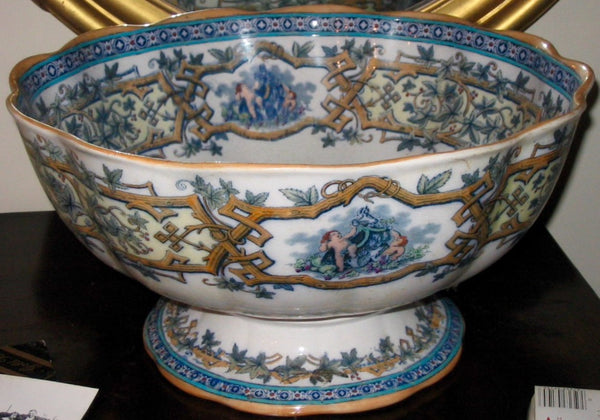This fine white Ironstone large scalloped center pedestal bowl has a white translucent quality. The cupids and leaves and the color of the flowers in true-to-life fashion, with the birds glazed to be realistic. The on the underside stamp is blurred, but shows the words I believe to be “Furnivals, England” in brown marking. The piece is bordered at the top in cobalt blue diamond motif. It has delicate flowers and scrolls with a larger group of cupids or “ putti" in the center. Each cupid with wings is surrounded by flowers. The inside an outside of the bowl has numerous cartouches of cupids and ornate foliage, each bordered by brown tree boughs. The base has cobalt blue borders and green ivy motif. The colors are vivid and bright.
Size: 8 1/2 “ tall x 16 1/2 “ diameter
Creative details make this an addition that will become a treasured part of your collection.
Condition: The large bowl is in fine condition; no chips or cracks, and no appreciable paint wear, no repairs. There may be a few small spots of losses to the decoration, some minor rubbing to the colors light glaze consistent with age.
I do not know how old this one may be, but from the mark I assume circa 1850.
Marked "Furnivals, England" on the bottom.
During the political upheaval of the French Revolution and Reformation periods, many people fled France for other countries, influencing the style and manner of plate decoration in English factories, as well. The porcelain that was produced by these same Sevres and Limoges decorators are in fact produced in England during this period and of the same quality, look and value as the old Sevres signature plates. Victorians admired 18th-century Sèvres porcelain, but authentic pieces in good condition were hard to come by. Even wealthy collectors were challenged to find something “in a perfect state & most positively old.”
Many English ceramic firms were influenced by historic French design. The designs here and there evoked 18th-century French porcelain.. The cobalt blue ground and seasonal allegories reflect the renewed appeal of the 18th-century.
(#2- 27 -- RM2)








